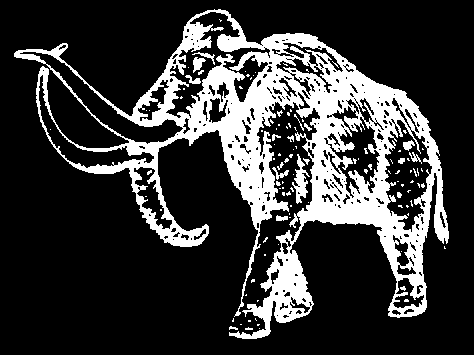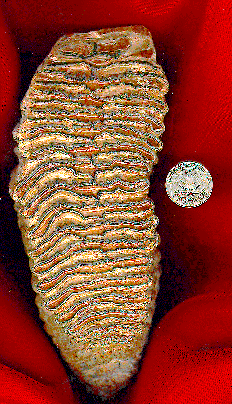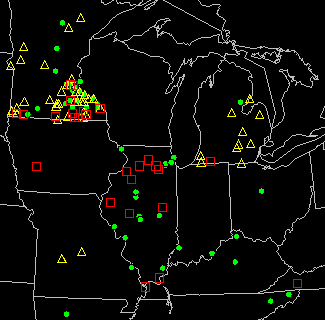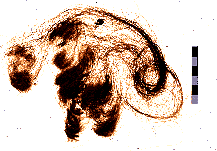
Three species of mammoths (genus Mammuthus) lived on the mainland of the United States at the end of the last Ice Age. These were the Columbian mammoth (M. columbi), Jefferson's mammoth (M. jeffersonii), and the woolly mammoth (M. primigenius). Of these, Jefferson's mammoth and the woolly mammoth have been identified from the midwestern U.S.
Mammoths, mastodons and modern elephants, are members of the order Proboscidea. The mammoths are closely related to the living elephants, especially to the Asiatic elephant (Elephas maximus).
As adults these late-occuring mammoths stood between about 3 and 3.7 meters (10-12 feet) at the shoulder and weighed between 5500 and 7300 kilograms (6-8 tons).

The teeth of mammoths are quite distinctive. They are composed of a set of compressed enamel plates that are held together with cementum. These cemented plates make a very tall, strong, and wear-resistant tooth. After a tooth erupts from the gum cavity, the mammoth uses it in grinding coarse vegetation like grass. This use causes the tooth to develop a flat top with low enamel ridges where the plates have been worn.
The tall structure of these hypsodont (shallow-rooted) teeth make them very resistant to wear. This is important because mammoths are thought to have been primarily grass-eaters. Grass is a very hard material to eat. It has small pieces of silica (a glass-like substance) in its leaves. These pieces of silica act like sandpaper grit and would wear away a less resistant tooth very quickly.
Mammoths are frequently found as fossils in the midwestern U.S. Most often isolated teeth are found. Mammoth fossils are most common in areas that were covered by savannas, grasslands, or tundra during the last Ice Age. This map shows some of the important mammoth finds in the region.

Approximately 1.5 to 1.8 million years ago the first mammoths entered North America. These mammoths came from Eurasia, crossing the Bering Strait at a time when sea level was lower than today. The first mammoths from Eurasia belonged to a species called M. meridionalis. The descendants of this species of mammoth included both the Columbian and Jefferson's mammoths. The woolly mammoths evolved in Eurasia and came over the Bering Strait much later (perhaps less than 500,000 years ago). Approximately 11,000 years ago all species of mammoths went extinct in North America.
Find out more about this extinction.
Although only bone and teeth of mammoths are preserved in the Midwestern U.S., the Illinois State Museum also has a sample of mammoth hair from Siberia.

This photograph shows a sample of hair from the Yuribei Mammoth. The Yuribei Mammoth was found along the Yuribei River on the Gyda Penisula, NW Siberia, Russia. It is a young adult, female mammoth. She was covered with a long and thick, brownish haircoat, an example of which is shown above. Radiocarbon dating indicates that she lived about 11,000 years ago.
The Yuribei Mammoth was collected in 1979 by a multidisciplinary team representing three institutes of the USSR Academy of Sciences.
The hair sample shown here was presented to the Illinois State Museum in 1991 by Dr. Gennady Baryshnikov, of the History of Faunas Department of the Zoological Insitute, Russian Academy of Sciences, St. Petersburg.